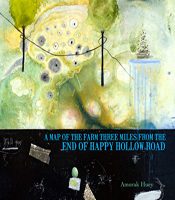It seems so important that I get this right…
So begins this slim volume that both confirms and condemns Thomas Wolfe’s sentiment that you can’t go home again.Throughout his chapbook, A Map of the Farm Three Miles from the End of Happy Hollow Road (Porkbelly Press), Amorak Huey proceeds to show us memory in distress: choked, dried, fevered, grabbing at our ankles. It is in this way that Huey avoids the pitfalls of nostalgia: by showing the reader a dark longing that hints at the knowledge we gain from distance, the high-definition of hindsight.
The poems are sparse, but powerful, almost proverbial in their language. Lines like “water seeks the easiest path to the river” and “a season for planting, a season for harvest” would be equally at home in an almanac or a hymnal, and the reverence here for the landscape of memory is a type of worship. For what is prayer but asking an entity we cannot see for something we cannot fully comprehend? This is what we do when we remember.
The opening poem gives us a speaker who binds these earthly and spiritual concerns by showing us
…the lonely child that I was,
never having learned the rules of prayer. Instead I offer
this uncurling body, this frog-song,
tornado-spike, voice-from-the-trees…
And that marriage—of the sacred and the profane, the simple and the philosophical—continues throughout the chapbook. Those recurring themes also come with careful attention to craft. The s sounds in “The Corn in the Valley” give us the familiar rustle of stalks that are moved by bodies or weather: “A sea of silk, a sky of stalk, a sun of ear and song.” Masterful wordplay gives us lines like “Trying to write failing, to write memory, I write family instead”; and Huey’s recurring use of hyphenated language in nearly every poem—creating words like frost-wary, finger-stain, pebble-hard, blossom-burst—continues to flip the coin of memory over and over in the air, revealing that, in the past, everything was not as it seemed and was exactly as it seemed.

Another example of Huey’s layered yet economical approach is the one-line poem “The Rock at the Top of the Hill”:
I have always been so clumsy with silence.
In this pairing of title and a single line is a confession full of the same potential energy as the rock, simultaneously stable and dangerous. That hint of darkness is what moves Huey’s poems out of the realm of reverie and into the realm of meditation. In the world this chapbook creates, time is a love triangle, a slippery stream. Here is a childhood full of cliffs where the speaker confesses, “I’m not getting this right. You cannot see what I mean for you to see.” Here is the ecstatic O! addressing broken promises, tested faith.
With repetitive fragmented structures, natural imagery, and hyphenate vocabulary, A Map of the Farm Three Miles from the End of Happy Hollow Road succeeds in taking us to a version of home that lives in our own flawed memories—imperfect and beautiful in its blurred lines, like an Impressionist painting. Huey’s bridged language keeps us suspended between the bucolic and the foreboding—tree branches that reach to places we cannot see, the rapid and surprising heartbeat of a rabbit between two strong hands. There are storms brewing in these poems, but there is also refuge. There is also love.




